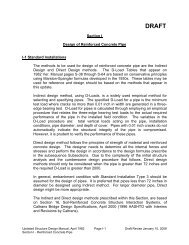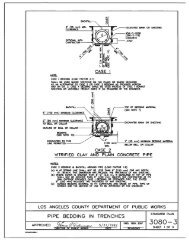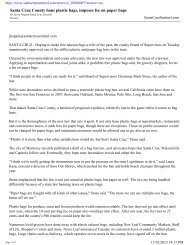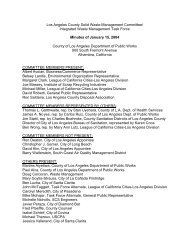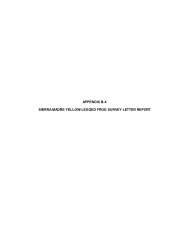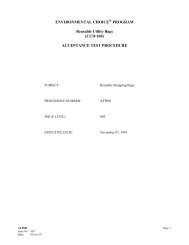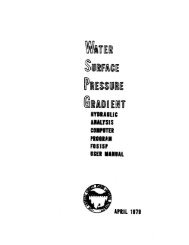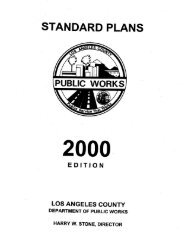Biological Resources - Department of Public Works
Biological Resources - Department of Public Works
Biological Resources - Department of Public Works
Create successful ePaper yourself
Turn your PDF publications into a flip-book with our unique Google optimized e-Paper software.
3.2.1 Introduction<br />
Section 3.2 | <strong>Biological</strong> <strong>Resources</strong><br />
This section describes the affected environment for biological resources, the regulatory setting<br />
associated with biological resources, the impacts on biological resources that would result from the<br />
project, and the mitigation measures that would reduce these impacts. The study area for biological<br />
resources consists <strong>of</strong> the entire County <strong>of</strong> Los Angeles.<br />
Additional information on biological resources is provided in Appendix C.<br />
The key sources <strong>of</strong> data and information used in the preparation <strong>of</strong> this section are listed and briefly<br />
described below.<br />
California <strong>Department</strong> <strong>of</strong> Fish and Game’s (CDFG) California Natural Diversity Database<br />
(CNDDB) (CDFG 2010) records.<br />
California Native Plant Society’s (CNPS’s) Inventory <strong>of</strong> Rare and Endangered Vascular Plants <strong>of</strong><br />
California (CNPS 2010).<br />
U.S. Fish and Wildlife Service (USFWS) National Wetlands Inventory (USFWS 2011).<br />
USFWS Critical Habitat Portal (USFWS 2010).<br />
2011 Google Earth aerial photographs.<br />
County <strong>of</strong> Los Angeles Draft General Plan (County <strong>of</strong> Los Angeles 2008).<br />
The following impact determinations were made in the County <strong>of</strong> Los Angeles Initial Study<br />
Checklist for the proposed project.<br />
Grading, fire clearance, or flood related improvements would not remove substantial natural<br />
habitat areas.<br />
The project would not result in impacts associated with other factors related to biological<br />
resources (e.g., wildlife corridor, adjacent open space linkage).<br />
These issues are not discussed further in this section.<br />
3.2.2 Regulatory Setting<br />
3.2.2.1 Federal<br />
Federal Endangered Species Act<br />
The federal Endangered Species Act (ESA) was enacted in 1973 to provide protection to threatened<br />
and endangered species and their associated ecosystems. “Take” <strong>of</strong> a listed species is prohibited<br />
except when specific authorization has been granted through a USFWS permit under Section 4(d), 7,<br />
ICF International | 3.2-19
County <strong>of</strong> Los Angeles | Bicycle Master Plan Draft PEIR 3.2 | <strong>Biological</strong> <strong>Resources</strong><br />
or 10(a) <strong>of</strong> the ESA. “Take” is defined as to harass, harm, shoot, wound, kill, trap, capture, or<br />
collect, or to attempt to engage in any <strong>of</strong> these activities without a permit.<br />
Federal Migratory Bird Treaty Act<br />
The Migratory Bird Treaty Act (MBTA) was enacted in 1918. Its purpose is to prohibit the kill or<br />
transport <strong>of</strong> native migratory birds, or any part, nest, or egg <strong>of</strong> any such bird unless allowed by<br />
another regulation adopted in accordance with the MBTA. A list <strong>of</strong> migratory bird species that are<br />
protected by the MBTA is maintained by the USFWS, which also regulates most aspects <strong>of</strong> the<br />
taking, possession, transportation, sale, purchase, barter, exportation, and importation <strong>of</strong> migratory<br />
birds.<br />
Clean Water Act<br />
In 1948, Congress first passed the Federal Water Pollution Control Act. This act was amended in<br />
1972 and became known as the Clean Water Act (CWA), which regulates the discharge <strong>of</strong> pollutants<br />
into the waters <strong>of</strong> the United States. Under Section 404, permits need to be obtained from the U.S.<br />
Army Corps <strong>of</strong> Engineers (USACE) for discharge <strong>of</strong> dredge or fill material into jurisdictional waters<br />
<strong>of</strong> the U.S. USACE-regulated activities under Section 404 involve a discharge <strong>of</strong> dredged or fill<br />
material including, but not limited to, grading, placing <strong>of</strong> riprap for erosion control, pouring<br />
concrete, laying sod, and stockpiling excavated material into waters <strong>of</strong> the U.S. Activities that<br />
generally do not involve a regulated discharge (if performed specifically in a manner to avoid<br />
discharges) include driving pilings, some drainage channel maintenance activities, constructing<br />
temporary mining and farm/forest roads, and excavating without stockpiling. USACE issues<br />
Nationwide Permits for activities that require discretionary authority and do not exceed specific<br />
impact requirements (e.g., less than 0.5 acre <strong>of</strong> impacts, no impacts on special aquatic sites, etc.) and<br />
requires individual permits for activities that exceed the requirements <strong>of</strong> Nationwide Permits.<br />
Under Section 401 <strong>of</strong> the act, Water Quality Certification from the State Water <strong>Resources</strong> Control<br />
Board (SWRCB)/Regional Water Quality Control Board (RWQCB) needs to be obtained if an<br />
action would potentially result in any impacts on jurisdictional waters <strong>of</strong> the U.S.<br />
3.2.2.2 State<br />
California Endangered Species Act (CESA)<br />
CESA prohibits the take <strong>of</strong> any species that the California Fish and Game Commission determines<br />
to be a threatened or endangered species. The act is administered by CDFG. Incidental take <strong>of</strong> these<br />
listed species can be approved by the CDFG.<br />
California State Fish and Game Code – Streambed Alteration Program<br />
The California Fish and Game Code mandates that “it is unlawful for any person to substantially<br />
divert or obstruct the natural flow or substantially change the bed, channel, or bank <strong>of</strong> any river,<br />
stream, or lake designated by the department, or use any material from the streambeds, without first<br />
notifying the department <strong>of</strong> such activity.” CDFG jurisdiction includes ephemeral, intermittent, and<br />
ICF International | 3.2-20
County <strong>of</strong> Los Angeles | Bicycle Master Plan Draft PEIR 3.2 | <strong>Biological</strong> <strong>Resources</strong><br />
perennial watercourses (including dry washes) and lakes characterized by the presence <strong>of</strong> (1)<br />
definable bed and banks and (2) existing fish or wildlife resources. Furthermore, CDFG jurisdiction<br />
is <strong>of</strong>ten extended to habitats adjacent to watercourses, such as oak woodlands in canyon bottoms or<br />
willow woodlands that function hydrologically as part <strong>of</strong> the riparian system. Under the CDFG<br />
definition, a watercourse need not exhibit evidence <strong>of</strong> an Ordinary High Water Mark (OHWM) to<br />
be claimed as jurisdiction.<br />
Under current California Fish and Game Code Sections 1600–1616, CDFG has the authority to<br />
regulate work that will substantially divert or obstruct the natural flow <strong>of</strong>, change, or use any<br />
material from the bed, channel, or bank <strong>of</strong> any river, stream, or lake. The CDFG also has authority<br />
to regulate work that will deposit or dispose <strong>of</strong> debris, waste, or other material containing crumbled,<br />
flaked, or ground pavement where it may pass into any river, stream, or lake. This regulation takes<br />
the form <strong>of</strong> a requirement for a Section 1602 Lake or Streambed Alteration Agreement (SAA) and is<br />
applicable to all projects involving state or local government discretionary approvals.<br />
California Coastal Act <strong>of</strong> 1976<br />
The California Coastal Act (CCA), administered by the California Coastal Commission (CCC),<br />
includes policies for development proposed within the coastal zone and recognizes California ports,<br />
harbors, and coastline beaches as economic and coastal resources. Decisions to implement specific<br />
development, where feasible, are to be based on consideration <strong>of</strong> alternative locations and designs in<br />
order to minimize any adverse environmental impacts. The CCC regulates all jurisdictional wetlands<br />
that are under the joint jurisdiction <strong>of</strong> USACE and RWQCBs, as well as riparian habitat under<br />
jurisdiction <strong>of</strong> CDFG. The CCA also defines “environmentally sensitive area” as “any area in which<br />
plant or animal life or their habitats are either rare or especially valuable because <strong>of</strong> their special<br />
nature or role in an ecosystem and which could be easily disturbed or degraded by human activities<br />
and developments” (Section 30107.5). The CCA requires that such areas be protected and that<br />
development project within or adjacent to such areas be planned and sited to prevent degradation <strong>of</strong><br />
environmentally sensitive areas.<br />
Porter-Cologne Water Quality Control Act<br />
The Porter-Cologne Water Quality Control Act (Porter-Cologne) is the California equivalent <strong>of</strong> the<br />
CWA. It provides for statewide coordination <strong>of</strong> water quality regulations through the establishment<br />
<strong>of</strong> the California SWRCB and nine separate RWQCBs that oversee water quality on a day-to-day<br />
basis at the regional/local level. The RWQCB regulates actions that would involve “discharging<br />
waste, or proposing to discharge waste, with any region that could affect the water <strong>of</strong> the state”<br />
(Water Code 13260(a)), pursuant to provisions <strong>of</strong> Porter-Cologne. Waters <strong>of</strong> the State are defined as<br />
“any surface water or groundwater, including saline waters, within the boundaries <strong>of</strong> the state”<br />
(Water Code 13050 (e)).<br />
The RWQCB also regulates waters <strong>of</strong> the U.S. under Section 401 <strong>of</strong> the CWA. A Water Quality<br />
Certification or a waiver must be obtained from the RWQCB if an action would potentially result in<br />
any impacts on jurisdictional waters <strong>of</strong> the U.S.<br />
ICF International | 3.2-21
County <strong>of</strong> Los Angeles | Bicycle Master Plan Draft PEIR 3.2 | <strong>Biological</strong> <strong>Resources</strong><br />
3.2.2.3 Local<br />
Los Angeles County Significant Ecological Areas<br />
As part <strong>of</strong> the General Plan Conservation/Open Space and Land Use elements, the County has<br />
identified and adopted policies for Significant Ecological Areas (SEAs), which represent a wide<br />
variety <strong>of</strong> biological communities within the County. The SEAs are intended to preserve and protect<br />
regional biodiversity; however, SEAs do not preclude limited compatible development.<br />
Los Angeles County Oak Tree Ordinance<br />
The Los Angeles County Oak Tree Ordinance is intended to preserve and maintain healthy oak trees<br />
in the County and places restrictions on development for their preservation. All trees <strong>of</strong> the oak<br />
genus (including Valley Oak and Coast Live Oak) with a trunk measuring 25 inches or more in<br />
circumference (8 inches in diameter) and more than 4.5 feet tall are legally protected from being<br />
damaged or removed during the course <strong>of</strong> a development project without first obtaining a permit.<br />
Exemptions to this ordinance include trees within existing road rights-<strong>of</strong>-way where pruning is<br />
necessary to maintain line-<strong>of</strong>-sight or where removal/relocation is necessary to maintain public<br />
facilities and infrastructure within existing road rights-<strong>of</strong>-way.<br />
3.2.3 Environmental Setting<br />
Los Angeles County is heavily urbanized, and most <strong>of</strong> the undeveloped land that remains is within<br />
unincorporated areas. The County is climatically and ecologically diverse and includes coastal,<br />
mountain, and desert ecosystems. The regional climate <strong>of</strong> the County is Mediterranean with most<br />
precipitation occurring in the winter months with a slightly increasing trend from south to north.<br />
The primary mountain ranges in the County include the Santa Monica Mountains and the San<br />
Gabriel Mountains. Surface water originating in the elevated areas <strong>of</strong> the County formed drainages<br />
that traverse the County and eventually flow into the Pacific Ocean, which borders the County along<br />
approximately 75 miles <strong>of</strong> coastline (except in the Antelope Valley, where water drains northward<br />
into the California Central Valley). Major drainage features in the County include the Los Angeles<br />
River, Rio Hondo, the San Gabriel River, and the Santa Clara River.<br />
The southern portion <strong>of</strong> the County has been extensively developed and, as a result, undisturbed<br />
habitat is generally found in smaller pockets and in areas where steep topography precludes<br />
development. The northern portion <strong>of</strong> the County supports more scattered, rural development and<br />
large blocks <strong>of</strong> undeveloped areas and natural open space, including the Angeles and Los Padres<br />
National Forests and the Mohave Desert.<br />
The County’s General Plan established SEAs, which represent a wide variety <strong>of</strong> biological<br />
communities within the County. SEAs occur throughout the County and range from areas along the<br />
Malibu coastline, areas within the Santa Monica Mountains, and portions <strong>of</strong> the Angeles National<br />
Forest and the Mohave Desert. Figures 3.2-1 and 3.2-2 depict existing SEAs within the County.<br />
ICF International | 3.2-22
k:\irvine\gis\projects\lacdpw\00044_11\mapdoc\2011aug\3_2_1_la_county_bikes_existprop_seas_west.mxd DD (08-01-11)<br />
Legend<br />
GORMAN<br />
WESTLAKE<br />
VILLAGE<br />
Significant Ecological Areas<br />
Proposed Bicycle Network<br />
Class I - Bike Path<br />
Class II - Bike Lane<br />
Class III - Bike Route<br />
Bicycle Boulevard<br />
VENTURA<br />
COUNTY<br />
±<br />
MALIBU<br />
AGOURA HILLS<br />
SANTA MONICA MOUNTAINS<br />
NORTH AREA<br />
MALIBU COASTAL ZONE<br />
VAL VERDE<br />
HASLEY<br />
CANYON<br />
WES<br />
CHATSWORTH<br />
WESTHILLS<br />
HIDDEN<br />
HILLS<br />
CALABASAS<br />
0 3 6 Miles<br />
NEENACH<br />
CASTAIC<br />
THREE<br />
POINTS<br />
TWIN<br />
AKES<br />
PACIFIC<br />
OCEAN<br />
!"^$<br />
OAT MOUNTAIN<br />
IÆ<br />
AÝE<br />
SANTA<br />
CLARITA<br />
LOS ANGELES<br />
%&l(<br />
WEST LOS ANGELES<br />
(SAWTELLE VA)<br />
SYLMAR<br />
ISLAND<br />
SAN<br />
FERNANDO<br />
AmE<br />
BEVERLY<br />
HILLS<br />
EL SEGUNDO<br />
%&l(<br />
INGLEWOOD<br />
HAWTHORNE<br />
%&g(<br />
IÆ<br />
!"`$<br />
?ßE<br />
%&e(<br />
!"^$<br />
?×E<br />
%&l(<br />
%&d(<br />
LANCASTER<br />
LA CANADA<br />
FLINTRIDGE<br />
%&q(<br />
AíE<br />
MAYWOOD<br />
LYNWOOD<br />
SOUTH<br />
PASADENA<br />
AÆE<br />
PALMDALE<br />
ALHAMBRA<br />
!"^$<br />
SAN MARINO<br />
SANTA<br />
MONICA MONTEBELLO<br />
MARINA<br />
DEL<br />
REY<br />
BALLONA<br />
WETLANDS<br />
SOURCE: ESRI Streetmap USA (2008); Significant Ecological Areas - Los Angeles County <strong>Department</strong> <strong>of</strong> Regional Planning<br />
BOUQUET<br />
CANYON<br />
FAIRMONT<br />
LAKE<br />
HUGHES<br />
FORREST<br />
PARK<br />
GREEN<br />
VALLEY<br />
FRANKLIN<br />
CANYON<br />
ELIZABETH<br />
LAKE<br />
LOPEZ CANYON<br />
CULVER<br />
CITY<br />
MANHATTAN<br />
BEACH<br />
HERMOSA<br />
BEACH<br />
PALOS VERDES<br />
ESTATES<br />
KAGEL CANYON<br />
WEST<br />
HOLLYWOOD<br />
DEL<br />
AIRE<br />
LANG<br />
LADERA HEIGHTS/<br />
VIEWPARK -<br />
WINDSOR HILLS<br />
REDONDO<br />
BEACH<br />
WESTFIELD<br />
RANCHO<br />
PALOS VERDES<br />
SOLEDAD -<br />
SULPHUR<br />
SPRINGS<br />
LAWNDALE<br />
UNIVERSAL<br />
CITY<br />
LENNOX<br />
ALONDRA<br />
PARK<br />
TORRANCE<br />
ROLLING HILLS<br />
ALPINE<br />
BURBANK<br />
W ATHENS -<br />
WESTMONT<br />
ROLLING HILL<br />
ESTATES<br />
LOMITA<br />
DEL SUR<br />
LEONA<br />
VALLEY<br />
AGUA<br />
DULCE<br />
GARDENA<br />
WEST<br />
CARSON<br />
LA RAMBLA<br />
ANTELOPE<br />
ACRES<br />
W RANCHO<br />
DOMINGUEZ<br />
- VICTORIA<br />
GLENDALE<br />
FLORENCE -<br />
FIRESTONE<br />
LOS ANGELES<br />
LA CRESCENTA -<br />
MONTROSE<br />
LOS ANGELES<br />
WILLOWBROOK<br />
COMPTON<br />
CARSON<br />
VERNON<br />
SOUTH GATE<br />
EAS<br />
RANCHO<br />
DOMINGUEZ<br />
RANCHO<br />
DOMINGUEZ<br />
QUARTZ<br />
HILL<br />
HUNTINGTON<br />
PARK<br />
ACTON<br />
CUDAHY<br />
PARAMOUNT<br />
COMMERCE<br />
LONG<br />
BEACH<br />
PASADENA<br />
?zE<br />
DOWNEY<br />
BELLFLOWER<br />
SAN<br />
GABRIEL<br />
%&o(<br />
!"`$<br />
%&g(<br />
PICO RIVERA<br />
ROSEMEAD<br />
EAST LOS<br />
MONTEREY<br />
ANGELES PARK<br />
WHITTIER<br />
%&q(<br />
SOUTH NARROWS<br />
SAN GABRIEL<br />
BELL<br />
WHITE FENCE FARMS -<br />
EL DORADO<br />
DESERT VIEW<br />
HIGHLANDS<br />
SIGNAL<br />
HILL<br />
LAKEVIEW<br />
BELL<br />
GARDENS<br />
ALTADENA<br />
EAST PASADENA -<br />
EAST SAN GABRIEL<br />
LAKEWOOD<br />
KINNELOA<br />
MESA<br />
WEST WHITTIER -<br />
LOS NIETOS<br />
Figure 3.2-1<br />
Western Los Angeles County Areas with Significant Ecological Areas<br />
Los Angeles County Bicycle Master Plan<br />
LONG BEACH<br />
ISLAND<br />
SANTA FE<br />
SPRINGS<br />
NORWALK<br />
ARTESIA<br />
CERRITOS<br />
HAWAIIAN<br />
GARDENS
OAT MOUNTAIN<br />
AÝE<br />
k:\irvine\gis\projects\lacdpw\00044_11\mapdoc\2011aug\3_2_2_la_county_bikes_existprop_seas_east.mxd DD (08-01-11)<br />
SANTA<br />
CLARITA<br />
BOUQUET<br />
CANYON<br />
LOS ANGELES<br />
%&l(<br />
WEST LOS ANGELES<br />
(SAWTELLE VA)<br />
SYLMAR<br />
ISLAND<br />
FAIRMONT<br />
LAKE<br />
HUGHES<br />
FORREST<br />
PARK<br />
SAN<br />
FERNANDO<br />
AmE<br />
BEVERLY<br />
HILLS<br />
EL SEGUNDO<br />
%&l(<br />
INGLEWOOD<br />
HAWTHORNE<br />
%&g(<br />
IÆ<br />
?ßE<br />
!"`$<br />
%&e(<br />
!"^$<br />
?×E<br />
%&l(<br />
%&d(<br />
LANCASTER<br />
LA CANADA<br />
FLINTRIDGE<br />
%&q(<br />
AíE<br />
MAYWOOD<br />
LYNWOOD<br />
SOUTH<br />
PASADENA<br />
%&q(<br />
AÆE<br />
PALMDALE<br />
ALHAMBRA<br />
!"^$<br />
SAN MARINO<br />
SANTA<br />
MONICA MONTEBELLO<br />
MARINA<br />
DEL<br />
REY<br />
BALLONA<br />
WETLANDS<br />
PACIFIC<br />
OCEAN<br />
GREEN<br />
VALLEY<br />
FRANKLIN<br />
CANYON<br />
ELIZABETH<br />
LAKE<br />
LOPEZ CANYON<br />
CULVER<br />
CITY<br />
MANHATTAN<br />
BEACH<br />
HERMOSA<br />
BEACH<br />
PALOS VERDES<br />
ESTATES<br />
KAGEL CANYON<br />
WEST<br />
HOLLYWOOD<br />
DEL<br />
AIRE<br />
LANG<br />
LADERA HEIGHTS/<br />
VIEWPARK -<br />
WINDSOR HILLS<br />
REDONDO<br />
BEACH<br />
WESTFIELD<br />
RANCHO<br />
PALOS VERDES<br />
SOLEDAD -<br />
SULPHUR<br />
SPRINGS<br />
LAWNDALE<br />
UNIVERSAL<br />
CITY<br />
LENNOX<br />
ALONDRA<br />
PARK<br />
TORRANCE<br />
ROLLING HILLS<br />
ALPINE<br />
BURBANK<br />
W ATHENS -<br />
WESTMONT<br />
ROLLING HILL<br />
ESTATES<br />
LOMITA<br />
DEL SUR<br />
LEONA<br />
VALLEY<br />
AGUA<br />
DULCE<br />
GARDENA<br />
WEST<br />
CARSON<br />
LA RAMBLA<br />
ANTELOPE<br />
ACRES<br />
W RANCHO<br />
DOMINGUEZ<br />
- VICTORIA<br />
GLENDALE<br />
FLORENCE -<br />
FIRESTONE<br />
LOS ANGELES<br />
LA CRESCENTA -<br />
MONTROSE<br />
LOS ANGELES<br />
WILLOWBROOK<br />
COMPTON<br />
CARSON<br />
VERNON<br />
SOUTH GATE<br />
EAS<br />
RANCHO<br />
DOMINGUEZ<br />
RANCHO<br />
DOMINGUEZ<br />
QUARTZ<br />
HILL<br />
HUNTINGTON<br />
PARK<br />
ACTON<br />
EAST LOS<br />
ANGELES<br />
BELL<br />
CUDAHY<br />
WHITE FENCE FARMS -<br />
EL DORADO<br />
DESERT VIEW<br />
HIGHLANDS<br />
PARAMOUNT<br />
SIGNAL<br />
HILL<br />
LAKEVIEW<br />
COMMERCE<br />
BELL<br />
GARDENS<br />
LONG<br />
BEACH<br />
ALTADENA<br />
PASADENA<br />
EAST PASADENA -<br />
EAST SAN GABRIEL<br />
MONTEREY<br />
PARK<br />
?zE<br />
DOWNEY<br />
BELLFLOWER<br />
LAKEWOOD<br />
SAN<br />
GABRIEL<br />
%&o(<br />
!"`$<br />
KINNELOA<br />
MESA<br />
%&g(<br />
PICO RIVERA<br />
WEST WHITTIER -<br />
LOS NIETOS<br />
SANTA FE<br />
SPRINGS<br />
NORWALK<br />
SIERRA<br />
MADRE<br />
TEMPLE<br />
CITY<br />
ROSEMEAD<br />
ARTESIA<br />
CERRITOS<br />
HAWAIIAN<br />
GARDENS<br />
%&o(<br />
ARCADIA<br />
EL MONTE<br />
SOUTH<br />
EL MONTE<br />
WHITTIER<br />
LA MIRADA<br />
MONROVIA<br />
SOUTH MONROVIA ISLANDS<br />
WHITTIER<br />
SOUTH<br />
SAN GABRIEL<br />
NARROWS<br />
AVOCADO<br />
HEIGHTS<br />
LONG BEACH<br />
ISLAND<br />
NORTH WHITTIER<br />
SOUTH<br />
WHITTIER -<br />
SUNSHINE ACRES<br />
ROOSEVELT<br />
BRADBURY<br />
IRWINDALE<br />
BALDWIN PARK<br />
WEST PUENTE<br />
VALLEY<br />
DUARTE<br />
LA HABRA<br />
HEIGHTS<br />
EAST<br />
IRWINDALE<br />
!"`$<br />
LA PUENTE<br />
ORANGE<br />
COUNTY<br />
SOURCE: ESRI Streetmap USA (2008); Significant Ecological Areas - Los Angeles County <strong>Department</strong> <strong>of</strong> Regional Planning<br />
REDMAN HI VISTA<br />
HACIENDA<br />
HEIGHTS<br />
VALINDA<br />
SUN VILLAGE<br />
PEARBLOSSOM<br />
AZUSA<br />
INDUSTRY<br />
WEST<br />
COVINA<br />
COVINA<br />
SOUTH SAN JOSE HILLS<br />
ROWLAND<br />
HEIGHTS<br />
ANTELOPE VALLEY<br />
EAST<br />
AZUSA<br />
CRYSTALAIRE<br />
WALNUT<br />
GLENDORA<br />
COVINA<br />
ISLANDS CHARTER<br />
OAK<br />
GLENDORA<br />
ISLANDS<br />
WEST<br />
SAN DIMAS<br />
WALNUT<br />
ISLANDS<br />
0 3 ± 6 Miles<br />
SOUTH WALNUT<br />
LAKE<br />
LOS ANGELES<br />
PARADISE<br />
CLAREMONT<br />
SAN DIMAS LA VERNE WEST<br />
CLAREMONT<br />
?uE<br />
DIAMOND BAR<br />
LLANO<br />
VALYERMO<br />
%&g(<br />
Legend<br />
NORTHEAST<br />
LA VERNE<br />
POMONA<br />
BIG PINES<br />
NORTH<br />
CLAREMONT<br />
WRIGHTWOOD<br />
SAN BERNARDINO<br />
COUNTY<br />
Significant Ecological Areas<br />
Proposed Bicycle Network<br />
Class I - Bike Path<br />
Class II - Bike Lane<br />
Class III - Bike Route<br />
Bicycle Boulevard<br />
Figure 3.2-2<br />
Eastern Los Angeles County Areas with Significant Ecological Areas<br />
Los Angeles County Bicycle Master Plan
County <strong>of</strong> Los Angeles | Bicycle Master Plan Draft PEIR 3.2 | <strong>Biological</strong> <strong>Resources</strong><br />
The physical and climatic conditions found in the County <strong>of</strong> Los Angeles provide for a wide variety<br />
<strong>of</strong> plants, wildlife, and biological communities. Beaches, canyons, mountains, deserts, parks, and<br />
even vacant lots surrounded by development can provide habitat for sensitive biological resources;<br />
native oak trees and other rare plants, raptors, bats, and songbirds can persist within even highly<br />
urbanized areas.<br />
The CNDDB lists over 250 sensitive species that may be found within the County <strong>of</strong> Los Angeles,<br />
including plant species, invertebrates, fish, reptiles, amphibians, birds, and mammals. Federally and<br />
state-listed plant and wildlife species identified by the CNDDB search as potentially occurring<br />
within the County are provided in Appendix C. The County <strong>of</strong> Los Angeles also supports critical<br />
habitat for several federally listed species, including the following: Braunton’s milk-vetch (Astragalus<br />
brauntonii), thread-leaved brodiaea (Brodiawa filifolia), Moran’s nosegay (Navarretia fossalis), coastal<br />
California gnatcatcher (Polioptila californica californica), least Bell’s vireo (Vireo bellii pusillus), Palos<br />
Verdes blue butterfly (Glaucopsyche lygdamus palosverdesensis), western snowy plover (Charadrius<br />
alexandrines nivosus), desert tortoise (Gopherus agassizii), Santa Ana sucker (Catostomus santaanae),<br />
tidewater goby (Eucyclogobius newberryi), and California red-legged frog (Rana draytonii) (USFWS 2010).<br />
The CNDDB also lists a total <strong>of</strong> 28 priority plant communities within the County (Table 3.2-1).<br />
Table 3.2-1. CNDDB List <strong>of</strong> Priority Plant Communities within the County <strong>of</strong> Los<br />
Angeles<br />
Plant Community<br />
Canyon Live Oak Ravine Forest California Walnut Woodland<br />
Mojave Riparian Forest Island Cherry Forest<br />
Southern California Arroyo Chub/Santa Ana<br />
Sucker Stream<br />
Island Ironwood Forest<br />
Southern California Coastal Lagoon Mainland Cherry Forest<br />
Southern California Steelhead Stream Maritime Succulent Scrub<br />
Southern California Threespine Stickleback<br />
Stream<br />
Open Engelmann Oak Woodland<br />
Southern Coast Live Oak Riparian Forest Riversidean Alluvial Fan Sage Scrub<br />
Southern Coastal Salt Marsh Southern Coastal Bluff Scrub<br />
Southern Cottonwood Willow Riparian Forest Southern Dune Scrub<br />
Southern Mixed Riparian Forest Southern Foredunes<br />
Southern Riparian Forest Valley Needlegrass Grassland<br />
Southern Riparian Scrub Valley Oak Woodland<br />
Southern Sycamore Alder Riparian Woodland Walnut Forest<br />
Southern Willow Scrub Wildflower field<br />
ICF International | 3.2-23
County <strong>of</strong> Los Angeles | Bicycle Master Plan Draft PEIR 3.2 | <strong>Biological</strong> <strong>Resources</strong><br />
3.2.4 Project Impacts and Mitigation Measures<br />
This section describes the impact analysis relating to biological resources for the Bicycle Master Plan<br />
at the program level. It describes the methods used to determine the impacts <strong>of</strong> the project and lists<br />
the thresholds used to conclude whether an impact would be significant. Measures to mitigate (i.e.,<br />
avoid, minimize, rectify, reduce, eliminate, or compensate for) significant impacts accompany each<br />
impact discussion, if necessary. Detailed analysis at the project level will determine the significance<br />
<strong>of</strong> impacts for individual Bicycle Master Plan projects and, if necessary, the applicability <strong>of</strong><br />
mitigation measures.<br />
3.2.4.1 Methods<br />
The impact analysis is a program-level analysis that evaluates development that is reasonably<br />
foreseeable if the Bicycle Master Plan is adopted and implemented. Based on the existing conditions<br />
described above, the impact analysis programmatically and qualitatively assesses the direct, indirect,<br />
and cumulative impacts on biological resources as a consequence <strong>of</strong> implementing the Bicycle<br />
Master Plan.<br />
3.2.4.2 Thresholds <strong>of</strong> Significance<br />
For this analysis, an impact pertaining to biological resources was considered significant if it would<br />
result in a “yes” answer to any <strong>of</strong> the following questions from the Los Angeles County Initial Study<br />
Checklist.<br />
Is the project site located within a SEA, SEA Buffer, or coastal Sensitive Environmental<br />
Resource (Environmentally Sensitive Habitat Area (ESHA), etc.), or is the site relatively<br />
undisturbed and natural?<br />
Is a drainage course located on the project site that is depicted on USGS quad sheets by a<br />
dashed blue line or that may contain a bed, channel, or bank <strong>of</strong> any perennial, intermittent, or<br />
ephemeral river, stream, or lake?<br />
Does the project site contain a major riparian or other sensitive habitat (e.g. coastal sage scrub,<br />
oak woodland, sycamore riparian, woodland, wetland, etc.)?<br />
Does the project site contain oak or other unique native trees (specify kinds <strong>of</strong> trees)?<br />
Is the project site habitat for any known sensitive species (federal or state listed endangered,<br />
etc.)?<br />
ICF International | 3.2-24
County <strong>of</strong> Los Angeles | Bicycle Master Plan Draft PEIR 3.2 | <strong>Biological</strong> <strong>Resources</strong><br />
3.2.4.3 Impacts and Mitigation Measures<br />
Impact 3.2-1: Be located within a SEA, SEA Buffer, or coastal ESHA,<br />
or is relatively undisturbed and natural.<br />
Construction<br />
The bicycle network’s impacts on biological resources would be site-specific. Such impacts would<br />
occur primarily through construction <strong>of</strong> Class I bike paths and on-road bikeways that would require<br />
widening within or adjacent to sites that contain sensitive environmental resources, are relatively<br />
undisturbed and natural, or are designated SEAs.<br />
As described in Section 3.2.3 above, SEAs have been designated throughout the County, including<br />
within areas where the bicycle network is proposed (Figures 3.2-1 and 3.1-2). In addition, large<br />
blocks <strong>of</strong> undisturbed and natural vegetation occur primarily within the northern portion <strong>of</strong> the<br />
County; however, even the most highly urbanized areas <strong>of</strong> the County support fragments <strong>of</strong> natural<br />
areas that could provide suitable habitat for sensitive species and that would be considered a<br />
sensitive environmental resource.<br />
In the event that construction occurs in areas within or adjacent to SEAs, SEA buffers, or areas<br />
supporting sensitive environmental resources (including drainage courses, riparian or other sensitive<br />
habitats, oaks or other unique native trees, and areas supporting sensitive species) the most common<br />
sources <strong>of</strong> impact would be the following:<br />
Removal or disturbance <strong>of</strong> vegetation (including areas that provide suitable foraging, nesting,<br />
and burrowing habitat for wildlife species).<br />
Alteration <strong>of</strong> surface drainage patterns through grading and installation <strong>of</strong> hard surfaces that<br />
affects vegetation and wildlife.<br />
Noise and light disturbance and dust deposition.<br />
Increased human and pet presence.<br />
Increased potential <strong>of</strong> exotic species invasion due to soil disturbance.<br />
Operation<br />
As with construction impacts, impacts on sensitive biological resources (including SEAs, SEA<br />
buffers, and environmentally sensitive habitat areas) resulting from operation <strong>of</strong> the bicycle network<br />
would be site-specific and would be dependent on several factors. These factors include the specific<br />
resources located adjacent to the proposed project site/bicycle network, the existing land uses<br />
surrounding the specific project site and associated noise/light levels, and the anticipated level <strong>of</strong> use<br />
<strong>of</strong> the proposed bicycle network in the project area. Operation <strong>of</strong> the bicycle network has the<br />
potential to result in significant impacts on SEAs, SEA buffers, and environmentally sensitive<br />
habitat areas, if present adjacent to proposed project sites.<br />
ICF International | 3.2-25
County <strong>of</strong> Los Angeles | Bicycle Master Plan Draft PEIR 3.2 | <strong>Biological</strong> <strong>Resources</strong><br />
Mitigation Measures<br />
Detailed analysis will be required prior to implementation <strong>of</strong> individual Bicycle Master Plan projects<br />
located within or adjacent to SEAs, SEA buffers, coastal ESHAs, or other relatively undisturbed or<br />
natural areas. This analysis will include a literature search conducted by a biologist with knowledge<br />
<strong>of</strong> the local biological conditions. Where appropriate in the opinion <strong>of</strong> the qualified biologist, the<br />
literature search will be supplemented with a site visit. <strong>Resources</strong> and information that will be<br />
investigated for each site should include, but not be limited to, the following:<br />
CNDDB<br />
CNPS Rare Plant Inventory<br />
National Wetlands Inventory<br />
USFWS Critical Habitat Portal<br />
Los Angeles County <strong>Department</strong> <strong>of</strong> Regional Planning for information on SEAs<br />
If it is determined by the qualified biologist that potentially significant impacts on sensitive biological<br />
resources could occur as a result <strong>of</strong> construction and/or operation <strong>of</strong> a specific project proposed<br />
under the Bicycle Master Plan, a comprehensive site-specific biological assessment will be conducted<br />
and a <strong>Biological</strong> <strong>Resources</strong> Technical Report will be prepared to identify potentially significant<br />
impacts and appropriate mitigation. The biological assessment will determine whether other<br />
site-specific focused surveys are required, such as a wetland delineation, focused rare plant surveys,<br />
or focused surveys for sensitive wildlife species. If determined to be necessary, such surveys will be<br />
conducted by a qualified biologist in accordance with established protocols or methodologies and<br />
during the appropriate time <strong>of</strong> year.<br />
MM 3.2-1: Obtain agency permits/approvals.<br />
If a project will impact resources under the jurisdiction <strong>of</strong> the USFWS, CDFG, SWRCB/RWQCB,<br />
USACE, and/or the CCC, the project will obtain the necessary permits/approvals from these<br />
agencies prior to construction and implement the associated conditions, if any.<br />
MM 3.2-2: Protect sensitive habitat areas from harmful exposure to light.<br />
If a project is within or adjacent to sensitive habitat areas (including SEAs, SEA buffers, habitat for<br />
sensitive species, etc.), the project will be designed to protect such areas from harmful exposure to<br />
light by shielding light sources, redirecting light sources, or using low intensity lighting.<br />
MM 3.2-3: Avoid impacts on nesting birds and raptors.<br />
If a project is constructed during the nesting season (February 15 – September 15) and<br />
tree/vegetation removal is necessary, one <strong>of</strong> the following will be conducted:<br />
All tree/vegetation removal will be prohibited during the nesting season to avoid potential<br />
impacts on nesting birds/raptors.<br />
ICF International | 3.2-26
County <strong>of</strong> Los Angeles | Bicycle Master Plan Draft PEIR 3.2 | <strong>Biological</strong> <strong>Resources</strong><br />
A qualified biologist will be retained to conduct pre-construction nesting bird surveys. If active<br />
nests are found, a “no work” buffer around the nest will be delineated by the qualified biologist<br />
and tree/vegetation removal will be delayed until the young have fledged or the nest has been<br />
abandoned for other reasons.<br />
MM 3.2-4: Conduct biological monitoring.<br />
If a project is within or adjacent to sensitive habitat areas (including SEAs, SEA Buffers, habitat for<br />
sensitive species, etc.), a biological monitor will be on site during construction activities within 100<br />
feet <strong>of</strong> sensitive habitat areas to ensure protection measures (i.e., flagging, fencing, etc. as noted in<br />
the mitigation measure below) are in place.<br />
MM 3.2-5: Delineate sensitive habitat areas.<br />
Sensitive habitat areas to be avoided, including appropriate buffers (determined by a qualified<br />
biologist), will be flagged by a qualified biologist prior to the onset <strong>of</strong> construction activities. Where<br />
indicated by the biologist, these areas will be fenced or otherwise protected from direct or indirect<br />
impacts. All such areas to be avoided will be clearly marked on construction plans and designated as<br />
“no construction” zones.<br />
MM 3.2-6: Install signage and fencing, vegetation, or other natural barriers to prevent<br />
impacts on adjacent areas during operation.<br />
Fencing, vegetation, or other natural barriers will be constructed to prevent impacts on sensitive<br />
habitat areas adjacent to the bicycle network during operation. Signs will be erected in appropriate<br />
locations to inform bicycle network users <strong>of</strong> the need to stay within designated bike paths, lanes,<br />
routes, and boulevards.<br />
Level <strong>of</strong> Significance after Mitigation<br />
With implementation <strong>of</strong> MM 3.2-1 through MM 3.2-6, impacts would be less than significant.<br />
Impact 3.2-2: Be located within a drainage course that is depicted on<br />
USGS quad sheets by a dashed blue line or that may contain a bed,<br />
channel, or bank <strong>of</strong> any perennial, intermittent or ephemeral river,<br />
stream, or lake.<br />
Construction<br />
The Bicycle Master Plan includes an expanded bikeway network in unincorporated communities and<br />
along rivers, creeks, channels, and flood control facilities. Direct impacts on drainage courses<br />
(including rivers, creeks, streams, and lakes) would occur if construction <strong>of</strong> the bicycle network<br />
resulted in the removal, filling, hydrological interruption, or other disturbance to these resources.<br />
Operation<br />
Operation <strong>of</strong> the bicycle network has the potential to result in significant impacts on drainage<br />
courses, if present adjacent to the footprint <strong>of</strong> a specific project proposed under the Bicycle Master<br />
ICF International | 3.2-27
County <strong>of</strong> Los Angeles | Bicycle Master Plan Draft PEIR 3.2 | <strong>Biological</strong> <strong>Resources</strong><br />
Plan. Operational impacts could occur as a result <strong>of</strong> increased human and pet presence and<br />
degradation <strong>of</strong> the functions and values <strong>of</strong> the drainage course resulting from accumulation <strong>of</strong> trash<br />
and debris.<br />
Mitigation Measures<br />
Detailed analysis will be required prior to implementation <strong>of</strong> individual Bicycle Master Plan projects<br />
located within or adjacent to drainage courses, as described for Impact 3.2-1.<br />
Impact 3.2-2 would be mitigated through implementation <strong>of</strong> measures MM 3.2-1 (Obtain agency<br />
permits/approvals), MM 3.2-4 (Conduct biological monitoring), MM 3.2-5 (Delineate sensitive<br />
habitat areas), and MM 3.2-6 (Install signage and fencing, vegetation, or other natural barriers to<br />
prevent impacts on adjacent areas during operation).<br />
Level <strong>of</strong> Significance after Mitigation<br />
With implementation <strong>of</strong> MM 3.2-1, MM 3.2-4, MM 3.2-5, and MM 3.2-6, impacts would be less than<br />
significant.<br />
Impact 3.2-3: Be located in a major riparian or other sensitive habitat.<br />
Construction<br />
Riparian and other sensitive habitats are known to occur within the County <strong>of</strong> Los Angeles (see<br />
Table 3.2-1) and could be impacted if present in or adjacent to the project footprint <strong>of</strong> a specific<br />
project to be implemented under the Bicycle Master Plan. Impacts on riparian or other sensitive<br />
habitats could occur through direct removal, potential invasion <strong>of</strong> exotic species due to soil<br />
disturbance, deposition <strong>of</strong> dust during construction, and increased human and pet presence.<br />
Operation<br />
Operation <strong>of</strong> the bicycle network has the potential to result in significant impacts on riparian or<br />
other sensitive habitat, if present adjacent to the footprint <strong>of</strong> a specific project proposed under the<br />
Bicycle Master Plan. Operational impacts could occur as a result <strong>of</strong> increased human and pet<br />
presence and degradation <strong>of</strong> habitat resulting from accumulation <strong>of</strong> trash and debris.<br />
Mitigation Measures<br />
Detailed analysis will be required prior to implementation <strong>of</strong> individual Bicycle Master Plan projects<br />
located within or adjacent to riparian areas and other sensitive habitats, as described for<br />
Impact 3.2-1.<br />
Impact 3.2-3 would be mitigated through implementation <strong>of</strong> measures MM 3.2-1 (Obtain agency<br />
permits/approvals), MM 3.2-2 (Protect sensitive habitat areas from harmful exposure to light),<br />
MM 3.2-3 (Avoid impacts on nesting birds and raptors), MM 3.2-4 (Conduct biological monitoring),<br />
MM 3.2-5 (Delineate sensitive habitat areas), and MM 3.2-6 (Install signage and fencing, vegetation,<br />
or other natural barriers to prevent impacts on adjacent areas during operation).<br />
ICF International | 3.2-28
County <strong>of</strong> Los Angeles | Bicycle Master Plan Draft PEIR 3.2 | <strong>Biological</strong> <strong>Resources</strong><br />
Level <strong>of</strong> Significance after Mitigation<br />
With implementation <strong>of</strong> MM 3.2-1 through MM 3.2-6, impacts would be less than significant.<br />
Impact 3.2-4: Be located near oak or other unique native trees.<br />
Construction<br />
Unique native trees (oak trees, western sycamore, California walnut, and Joshua trees) are known to<br />
occur within the County. Specific projects proposed under the Bicycle Master Plan could result in<br />
the removal <strong>of</strong> oak or other unique native trees, if present within the site-specific project impact<br />
area.<br />
Operation<br />
Operation <strong>of</strong> the proposed trail network would not result in direct or indirect impacts on oaks or<br />
other unique native trees.<br />
Mitigation Measures<br />
Detailed analysis will be required prior to implementation <strong>of</strong> individual Bicycle Master Plan projects<br />
located in areas containing oaks and other unique native trees, as described for Impact 3.2-1.<br />
Impact 3.2-4 would be mitigated through implementation <strong>of</strong> measures MM 3.2-1 (Obtain agency<br />
permits/approvals), MM 3.2-2 (Protect sensitive habitat areas from harmful exposure to light),<br />
MM 3.2-3 (Avoid impacts on nesting birds and raptors), MM 3.2-4 (Conduct biological monitoring),<br />
MM 3.2-5 (Delineate sensitive habitat areas), and MM 3.2-6 (Install signage and fencing, vegetation,<br />
or other natural barriers to prevent impacts on adjacent areas during operation).<br />
MM 3.2-7: Replace native trees.<br />
Individual projects implemented under the Bicycle Master Plan will minimize impacts on oaks and<br />
other unique native trees to the extent feasible and will comply with the County’s Oak Tree<br />
Ordinance. If impacts on oaks (not protected by the ordinance) and/or other unique native trees are<br />
unavoidable, the following will be conducted: (1) remove the tree and move it to another location<br />
adjacent to the impact area where conditions are favorable for survival <strong>of</strong> the tree; or (2) provide for<br />
in-kind replacement <strong>of</strong> each tree within an adjacent area outside <strong>of</strong> the impact footprint at a ratio <strong>of</strong><br />
2:1.<br />
Level <strong>of</strong> Significance after Mitigation<br />
With implementation <strong>of</strong> MM 3.2-1 through MM 3.2-7, impacts would be less than significant.<br />
Impact 3.2-5: Be located in habitat for any known sensitive species.<br />
Construction<br />
As discussed in Section 3.2.3 above, a search <strong>of</strong> the CNDDB identified over 250 sensitive species<br />
with potential to occur in the County. If present within or adjacent to an identified project footprint<br />
ICF International | 3.2-29
County <strong>of</strong> Los Angeles | Bicycle Master Plan Draft PEIR 3.2 | <strong>Biological</strong> <strong>Resources</strong><br />
<strong>of</strong> an individual project to be constructed under the Bicycle Master Plan, potentially significant<br />
impacts on sensitive species and suitable habitat could occur. Such impacts could occur through<br />
direct removal <strong>of</strong> suitable/occupied habitat; degradation <strong>of</strong> suitable/occupied habitat as a result <strong>of</strong><br />
increased human and pet presence, dust during construction, and potential invasion <strong>of</strong> exotic species<br />
due to soil disturbance; increased noise during construction; and increased light disturbance.<br />
Operation<br />
As with construction impacts, impacts on sensitive species resulting from operation <strong>of</strong> the bicycle<br />
network would be site-specific and would be dependent on several factors, including the specific<br />
resources located adjacent to the proposed project site/bicycle network, existing land uses<br />
surrounding the specific project site and associated noise levels, and the anticipated level <strong>of</strong> use <strong>of</strong><br />
the proposed bicycle network in the project area. Operation <strong>of</strong> the bicycle network has the potential<br />
to result in significant impacts on sensitive species, if present adjacent to proposed project sites.<br />
Mitigation Measures<br />
Detailed analysis will be required prior to implementation <strong>of</strong> individual Bicycle Master Plan projects<br />
located within relatively undisturbed or natural areas where sensitive species may occur, as described<br />
for Impact 3.2-1.<br />
Impact 3.2-5 would be mitigated through implementation <strong>of</strong> measures MM 3.2-1 (Obtain agency<br />
permits/approvals), MM 3.2-2 (Protect sensitive habitat areas from harmful exposure to light),<br />
MM 3.2-3 (Avoid impacts on nesting birds and raptors), MM 3.2-4 (Conduct biological monitoring),<br />
MM 3.2-5 (Delineate sensitive habitat areas), and MM 3.2-6 (Install signage and fencing, vegetation,<br />
or other natural barriers to prevent impacts on adjacent areas during operation).<br />
Level <strong>of</strong> Significance after Mitigation<br />
With implementation <strong>of</strong> MM 3.2-1 through MM 3.2-6, impacts would be less than significant.<br />
3.2.5 Cumulative<br />
The geographic scope for the cumulative analysis includes the County <strong>of</strong> Los Angeles. Past and<br />
present development projects have changed the overall natural setting <strong>of</strong> the County to moderateto-high<br />
density, primarily automobile-oriented communities with blocks <strong>of</strong> natural areas preserved<br />
or currently undeveloped. Impacts from past, present, and reasonably foreseeable future projects<br />
within the cumulative study area have been cumulatively considerable.<br />
Although past projects have shaped the existing development conditions within portions <strong>of</strong> the<br />
County, there are still sensitive biological resources within the County limits. Future projects<br />
implemented under the Bicycle Master Plan could result in significant impacts on sensitive biological<br />
resources. In light <strong>of</strong> these potential biological impacts from foreseeable development, specific<br />
mitigation measures are proposed to reduce such potential impacts to below a level <strong>of</strong> significance.<br />
With implementation <strong>of</strong> these measures and in consideration <strong>of</strong> the small scale <strong>of</strong> the proposed<br />
development associated with an expanded bicycle network within the County, the Bicycle Master<br />
ICF International | 3.2-30
County <strong>of</strong> Los Angeles | Bicycle Master Plan Draft PEIR 3.2 | <strong>Biological</strong> <strong>Resources</strong><br />
Plan’s contribution to further reducing sensitive biological resources in the cumulative study area<br />
would be less than cumulatively considerable. Therefore, the Bicycle Master Plan’s incremental<br />
contribution to cumulative biological resources impacts from past, present, and reasonably<br />
foreseeable future projects would be less than cumulatively considerable.<br />
ICF International | 3.2-31
This page intentionally left blank.<br />
ICF International | 3.2-32



